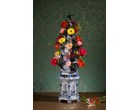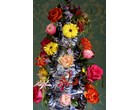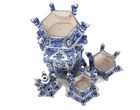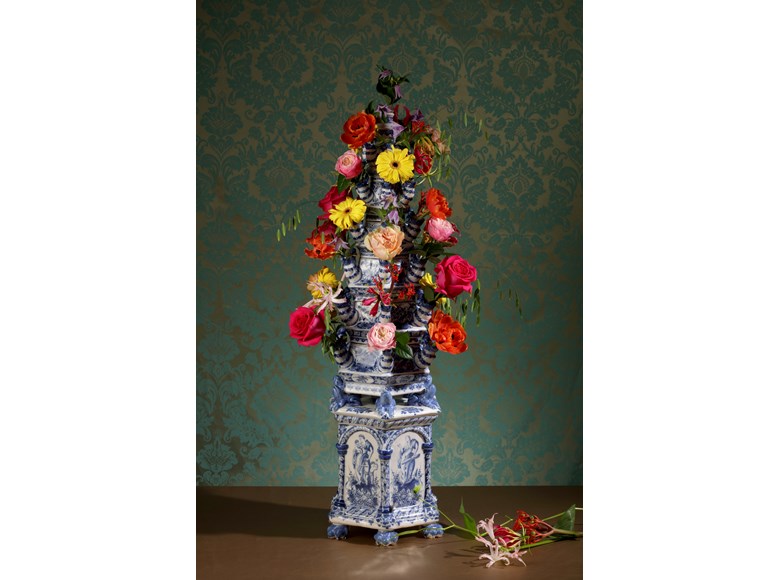 BACK TO GALLERY
BACK TO GALLERY
Aronson of Amsterdam
Adrianus Kocx
Blue and White Pyramidal Flower Vase
Marked AK for Adrianus Kocx, owner of The Greek A factory (1686-1701)
37.4 inches high
description
Blue and White Pyramidal Flower Vase
Delft, circa 1690
Marked with AK on the top of the plinth for Adrianus Kocx, the owner of De Grieksche A (The Greek A) factory from 1686 through 1701
Comprised of six segments on top of the large hexagonal base. The hexagonal base supported by paw feet under a foot-rim with a demi-ruyi-head band molded on each side with an architectural arch- shaped slightly recessed panel painted between columns bordered with foliage, with allegorical figures emblematic of Faith, Hope and Love. Each subject is repeated. The slightly canted upper and lower borders with a blue ground and decorated with leaves and scrolls, encircled by six triangular lotus and scroll ornaments in the interstices between six blue recumbent frogs supporting the six hexagonal tiers above; each tier with six open-mouthed fantasy animal heads forming the spouts, their necks encircled with two molded bands of circlets, and on the first tier painted between each on the first two tiers with a peacock perched on a rock amidst flowering plants, on the third tier with a peacock perched on a branch with double peony, on the fifth tier a peacock perched on breaches and the top with triangular floral devices.
DIMENSIONS Height: 95cm. (37.4in.)
NOTE The pyramid-shaped flower vases that are still present today in museums and private collections were certainly not part of the regular assortment of the Delft potters. The production process was highly complicated and expensive. Due to marked examples, we know that of the approximately 30 pottery company’s circa five companies were involved in the production of flower vases. De Grieksche A (The Greek A), De Metaale Pot (The Metal Pot) and De Witte Sterre (The White Star) were at the top of the list. Over a period of sixty years from around 1680 to 1740, they sold a multitude of different types of vases with spouts and holes.1 The royal and noble clientele was always looking for the latest and extraordinary models, to impress their friends and relatives. Flower pyramids were often placed in fireplaces, when they were out of use in the summer time.
The main ambassador for Delftware was Queen Mary (1662-1694) II the consort of William II, Prince of Orange, Stadhouder of the Netherlands. In 1686, the famous French designer Daniel Marot (1661- 1752) came to the Netherlands and because of his artistic qualities he soon entered the service of the royal couple.
Delft, circa 1690
Marked with AK on the top of the plinth for Adrianus Kocx, the owner of De Grieksche A (The Greek A) factory from 1686 through 1701
Comprised of six segments on top of the large hexagonal base. The hexagonal base supported by paw feet under a foot-rim with a demi-ruyi-head band molded on each side with an architectural arch- shaped slightly recessed panel painted between columns bordered with foliage, with allegorical figures emblematic of Faith, Hope and Love. Each subject is repeated. The slightly canted upper and lower borders with a blue ground and decorated with leaves and scrolls, encircled by six triangular lotus and scroll ornaments in the interstices between six blue recumbent frogs supporting the six hexagonal tiers above; each tier with six open-mouthed fantasy animal heads forming the spouts, their necks encircled with two molded bands of circlets, and on the first tier painted between each on the first two tiers with a peacock perched on a rock amidst flowering plants, on the third tier with a peacock perched on a branch with double peony, on the fifth tier a peacock perched on breaches and the top with triangular floral devices.
DIMENSIONS Height: 95cm. (37.4in.)
NOTE The pyramid-shaped flower vases that are still present today in museums and private collections were certainly not part of the regular assortment of the Delft potters. The production process was highly complicated and expensive. Due to marked examples, we know that of the approximately 30 pottery company’s circa five companies were involved in the production of flower vases. De Grieksche A (The Greek A), De Metaale Pot (The Metal Pot) and De Witte Sterre (The White Star) were at the top of the list. Over a period of sixty years from around 1680 to 1740, they sold a multitude of different types of vases with spouts and holes.1 The royal and noble clientele was always looking for the latest and extraordinary models, to impress their friends and relatives. Flower pyramids were often placed in fireplaces, when they were out of use in the summer time.
The main ambassador for Delftware was Queen Mary (1662-1694) II the consort of William II, Prince of Orange, Stadhouder of the Netherlands. In 1686, the famous French designer Daniel Marot (1661- 1752) came to the Netherlands and because of his artistic qualities he soon entered the service of the royal couple.










 SEND AN EMAIL
SEND AN EMAIL
 01131206233103
01131206233103